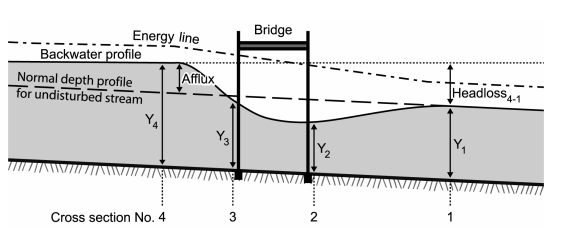What is Afflux in Hydraulic Flood Modelling?
Afflux is an increase in turbulent water level where the upstream of a structure is obstructing the flow path that is less than the natural width.
Afflux refers to the predicted change, usually in flood levels, between two scenarios. It is frequently used as a measure of the change in flood levels between an existing scenario and a proposed scenario. TUFLOW Manual, 2019
The below video developed in OpenFOAM - a free CFD Modelling program - shows afflux in motion.
What is hydraulic afflux?
Afflux is important in hydraulic modelling and flooding assessments due to the potential risks associated with structures along major arterial roads that traverse waterways. Bridges, culverts, and ford crossings are three key hydraulic structures that have potential to cause significant flood risk to the nearby community. This is due to their blockage factor which causes elevated water levels upstream and higher velocities downstream of the structure.
Figure 1 below shows a watercourse with a bridge structure acting as the hydraulic control. The broken line in the middle of the figure represents a normal surface water level without any obstructions, such as the bridge. The afflux is represented by the difference in increased backwater, created by the structures redistribution of energy and flow direction and the undistributed normal surface water. The top “energy line” is the outcome of a structure being placed in a waterway where there is a local loss of flow energy.

“afflux … the rise in water level upstream due to the obstruction (embankment)”
ARR2016 Book 6, Chapter 3
Why is afflux important to hydraulic flood modelling?
To put it simply, the higher change in water level, or afflux, the higher the risk of flooding. Afflux measurement is important to observe the impacts of any potential new structure to the local community and environment.
The elevated water levels upstream of structures are the cause of property, parcel and infrastructure inundation. This is generally due to structures being located in urban areas, though issues still arise in rural areas with structures impacting upstream properties inundating large pasture or agricultural areas. These impacts increase with higher flood levels, flow rates, and degree of obstruction and blockages are generally compared to the 1% AEP Flood Event.
Victoria’s Catchment Management Authorities (CMAs) have guidelines for bridge, culvert and ford crossing design to prevent afflux, shown below. This is to understand the regulated design, potential risks and incidents of flooding. These guidelines are predominantly acted upon if the structure traverses a designated waterway.
North Central CMA (NCCMA) guidelines: Bridges, Culverts, Ford Crossings
Goulburn Broken CMA (GBCMA) guidelines: Bridges, Culverts, Ford Crossings
West Gippsland CMA (WGCMA) guidelines: Bridges, Culverts, Ford Crossings
North East CMA (NECMA) guidelines: Bridges, Culverts, Ford Crossings
Corangamite CMA (CCMA) guidelines: Contact CCMA designated waterway
East Gippsland CMA (EGCMA) guidelines: Contact EGCMA designated waterway
Wimmera CMA (WCMA) guidelines: Contact WCMA designated waterway
These guidelines are very simplistic overviews of what CMAs will require when a new hydraulic structure is proposed. To see which CMA region you fall under, see here.
References
Atabay, Serter & Seckin, Galip. (2009). Prediction of afflux on undistorted scale bridge model. Canadian Journal of Civil Engineering. 36. 1051-1058. 10.1139/L09-045.
Atabay, Serter et al. “Prediction of afflux of bridge constriction with piers using Artificial Neural Network.” 2011 Fourth International Conference on Modeling, Simulation and Applied Optimization (2011): 1-4.
Lamb, R., Mantz, P., Atabay, S., Benn, J., and Pepper, A., (2006) Recent advances in modelling flood water levels at bridges and culverts. Unpublished Technical paper presented for JBA Consulting Engineers & Scientists.
Liu, Haifei & li, Min & Zhou, J & Burrows, Ruain. (2010). Bridge Afflux Predictions Using the Lattice Boltzmann Method. Energy Policy – ENERG POLICY. 2. 1881-1893. 10.1016/j.proenv.2010.10.200.
Mazumber, S.K., Dhiman, R. Computation of afflux with particular reference to widening of bridges on a roadway. Unpublished Technical paper for I.C.T Pvt. Ltd.
